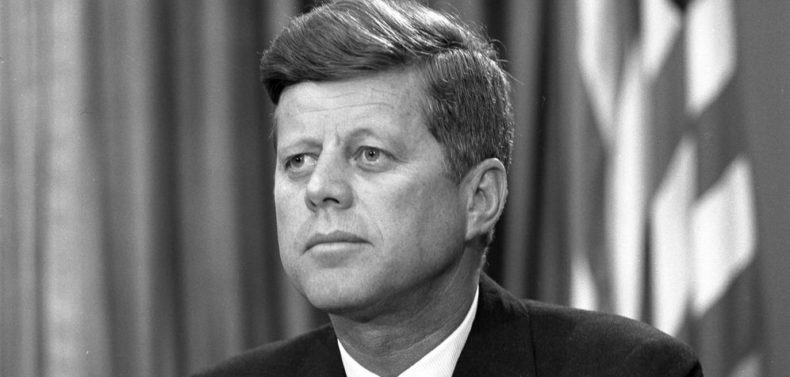“The government’s release of long-secret JFK assassination records is generating headlines and hype worldwide. But the truth is the majority of the JFK files that were supposed to be released last month remain secret—and may forever if the CIA has its way.”
—Jeff Morley, Nov. 20, 2017
The recent astonishing refusal of President Trump to release in full the contents of all remaining classified JFK assassination files confirms that more than half a century after the assassination the governmental coverup of the full truth about that dreadful murder is still underway.
In 1992, nearly three decades after JFK was slain by hidden sniper fire in Dallas, TX, on Nov. 22, 1963, Congress without any dissenting votes passed a statute “to provide for the expeditious disclosure of records relevant to the assassination of President John F. Kennedy.”
Prior to passage of this 1992 law, hundreds of thousands of government documents on the assassination were kept secret, and the few documents that were made available to the public were released only in the discretion of the government agencies in possession of them. It was to remedy this absurd situation that the President John F. Kennedy Assassination Records Collection Act of 1992 was enacted. Since passage of the statute, 5 million pages of assassination documents have been released by the National Archives.
In section 2 of the 1992 statute, Congress made a number of official declarations, including these four key ones:
(1) “all Government records related to the assassination of President John F. Kennedy should be preserved for historical and governmental purposes;”
(2) “all Government records concerning the assassination of President John F. Kennedy should carry a presumption of immediate disclosure;”
(3) “all [these] records should be eventually disclosed to enable the public to become fully informed about the history surrounding the assassination;” and
(4) “most of the records related to the assassination of President John F. Kennedy are almost 30 years old, and only in the rarest cases is there any legitimate need for continued protection of such records.”
Even more importantly, section 5 of the 1992 statute required, subject to one exception, full public disclosure of all the government’s JFK assassination records but generously gave government agencies a quarter of a century to comply with this requirement:
“Each assassination record shall be publicly disclosed in full, and available in the Collection [of the National Archives] no later than [Oct. 26, 2017], unless the President certifies, as required by this Act, that—
(i) continued postponement is made necessary by an identifiable harm to the military defense, intelligence operations, law enforcement, or conduct of foreign relations; and
(ii) the identifiable harm is of such gravity that it outweighs the public interest in disclosure.”
The mandate of the JFK Records Act is beyond dispute. All government JFK assassination records are required to be disclosed in full to the public by Oct. 26, 2017, absent a certification by the President of the United States that the public interest in disclosure is outweighed by the type of identifiable harm specified in the statute.
On Oct. 25, 2017, the day before the statutory deadline for full disclosure of the remaining JFK records, there were approximately 30,000 documents (most of which were from the CIA, FBI, or Department of Justice) awaiting release. Around 3,100 of these documents had been withheld in full; the remaining 26,900 or so had been previously released but with redactions.
And what happened the next day, Oct. 26, when all 30,000 documents were supposed to be disclosed in full? “A travesty,” writes assassination researcher Rex Bradford. Shortly before 8 p.m. the National Archives released 2,891 documents (many with redactions), less than 10 percent of the 30,000 documents awaiting full disclosure. And only 52 of the documents released that day had never before been seen by the public. Thus, on the very date Congress fixed 25 years earlier for full disclosure of all the government’s JFK assassination records, (1) 90 percent of the documents (or portions of documents) due for release and 98 percent of the documents which had previously been withheld in their entirety, were still being withheld, and (2) documents that were being released to the public still contained redactions.
The government’s failure to release in full all its classified JFK documents was due to an 11th-hour decision by President Trump to block their release. “If President Donald Trump had gone golfing at Mar-A-Lago and done absolutely nothing on [Oct. 26], the National Archives would have released all documents, as it was set to do,” Rex Bradford observes. But Trump did step in and by executive order on Oct. 26 postponed for up to six months (and possibly longer) the release of the classified documents (and portions of classified documents) not yet released.
The unambiguous language of the 1992 JFK Records Act required that the 30,000 documents awaiting release on Oct. 25 be fully disclosed no later than the next day unless the President of the United States determined that disclosure would harm national security and that this harm outweighed the public interest in disclosure. Therefore, President Trump’s directive to postpone further release of JFK documents was lawful only if, in accordance with the 1992 statute, he made the requisite statutory certification of identifiable harm.
But Trump did no such thing. He did something he was not authorized to do. Trump determined that postponement was necessary to give the CIA and other agencies an additional six months to review the thousands of documents not yet released in full. Instead of making the certification required by the 1992 statute, he certified instead that “all information within the records” of the agencies requesting redaction must be “temporarily withheld” in order “to allow sufficient time to determine whether such information warrants continued postponement under the Act.”
In short, President Trump did not, as the statute requires, block release on grounds release would harm the national security. Instead, he blocked release on grounds it would be harmful to the national security not to give government agencies (who had already had 25 years to raise any objections to release) another six months to determine whether information in the records of the agencies warrants further postponement of release of that information. “The law says ‘no later than 25 years’ unless there is identifiable harm,” assassination researcher Bill Simpich comments caustically. “Trump had to resort to asking for an additional six months to see if there was an identifiable harm. Sorry. Time is up.”
Not having made the certification required by law, President Trump acted in defiance of law when he interfered with the scheduled release of the remaining government JFK files. If Trump’s decision to postpone further release of JFK files is of doubtful legality, Trump’s simultaneous claim that “I am ordering today that the veil finally be lifted” is preposterous on its face.
We know why Trump made his curious Oct. 26 decision. It resulted from days of back-room maneuvering and lobbying behind the scenes by the CIA and other agencies, the same outfits that have participated in the JFK assassination coverup. During the weeks before Trump made his decision these agencies secretly and forcefully urged Trump to block full release of the files, besieging him with hundreds of last-minute requests that various documents be withheld in whole or in part. When he issued his postponement directive President Trump was bowing to fierce pressure from the very agencies which for decades have impeded discovery of the truth about JFK’s murder.
Press accounts of President Trump’s decision to intervene and halt disclosure of JFK documents scheduled for release suggest that with some exceptions the mainstream media swallowed whole Trump’s demonstrably false statement about what he was doing. Most journalists covering the story failed to comprehend that solely on account of Trump’s executive order the American people got about 2,800 documents, many in redacted form, rather than the 30,000 unredacted documents they were entitled to. “Trump Allows Release of Most But Not All Remaining Kennedy Assassination Files,” says one headline. One news story characterized Trump’s actions as “deferr[ing] to a request from the FBI and CIA to withhold 300 documents for at least 180 days…” Another news article announced that the government had “released over 2,800 records in an effort to comply with a 1992 law… but kept roughly 300 files classified…”
Surprisingly, and notwithstanding President Trump’s executive order, there have been two additional releases of JFK assassination documents since Oct. 26. These releases do not, however, undercut Bill Simpich’s straightforward contention that “[w]hat has happened completely violates the JFK [Records] Act of 1992, which was designed to ensure that all the records of the assassination went into the hands of the people.”
On Nov. 3, the National Archives released 676 documents, 582 of which had previously been withheld in full. Some of these files, however, are heavily redacted or obviously purged of assassination-related data, or both.
For example, the personnel file of David Sanchez Morales, deputy chief of the CIA’s Miami station in 1963, who was involved in various covert CIA plots to assassinate Fidel Castro and others, and is regarded by many responsible researchers as a likely suspect in a possible CIA-related conspiracy to kill JFK, contains 61 pages, 58 of which are completely redacted. The CIA file on Directorio Revolucionario Estudiantil, a militant anti-Castro student exile group which for years was secretly funded and run by the CIA, is not only suspiciously thin (a mere 87 pages) but has 61 pages entirely redacted, with the remaining 26 pages partially redacted. (Anti-Castro Cuban exile organizations have for years been suspected by researchers of possibly having been involved with the CIA in plotting JFK’s assassination.) And the personnel file of David Atlee Phillips, a CIA agent who appears to have had clandestine meetings with Lee Harvey Oswald prior to JFK’s murder, has numerous redactions and is suspiciously free of any documents covering the period 1961–1965. (Phillips was a CIA agent from 1954–1975.)
On Nov. 9, the National Archives released 13,213 more documents, most with redactions. The great majority of these documents had previously been released in somewhat different redacted form. Only four of these documents had previously been withheld in full, and one of these four documents has 48 of its 52 pages completely redacted.
At present, therefore, 54 years after JFK was assassinated, and 25 years after enactment of the JFK Records Act, thousands of documents that should be in the public domain are still being withheld in whole or in part. And the consensus of researchers is that the documents still being withheld will be of far greater significance than the documents already disclosed. “The JFK files Trump withholds will be more important than the releases,” according to distinguished researcher Jeff Morley, who has been investigating the assassination for 30 years and has his own JFK website.
Scandalously, President Trump, at the instigation of the CIA and other national security agencies, has denied the American people information about a presidential murder which Congress intended they should have by now. But this does not mean that recently released government documents do not reveal important and surprising new facts about the JFK assassination.
It is true that no “smoking gun” has yet appeared in the newly released documents, but it is equally true that there has not been enough time for researchers to thoroughly analyze and digest the contents of the previously withheld documents. And from the documents researchers have discovered some amazing factual information that has been withheld from the American public for over 50 years.
Here are a few samples:
Earle Cabell, the mayor of Dallas at the time of JFK’s assassination, was a CIA asset and had been since 1956. This eye-popping fact, Jeff Morley notes, “illuminate[s] that the CIA’s extraordinary penetration of domestic American institutions extended to the city where JFK was killed.” Morley adds: “If anyone had said over the past 50 years that the mayor of Dallas in 1963 was a CIA asset, they would have been derided as a ‘conspiracy theorist.’ Now we know for a fact that he was.” (Earle Cabell’s brother, Charles Cabell, we have long known, was a high-ranking CIA official until 1962 when he was forced out by JFK.)
Important CIA records on Lee Harvey Oswald once known to exist have now vanished. For example, one of the seven volumes on Oswald kept by the CIA’s Office of Security has mysteriously gone missing. One of the most secretive units of the CIA, the Office of Security was under the jurisdiction of the director of counterintelligence; and the fact that before the assassination the agency’s Oswald files were kept there is indicative of the CIA’s extraordinary interest in Oswald while JFK was still alive.
Numerous other significant government records on the JFK assassination have disappeared, and there is a sinister pattern to these disappearances. Commenting on these missing records, assassination researcher and university professor John Newman notes: “The records that disappeared all seemed to be important… There was a consistency in the type of information that went missing. The high number of incidents seem[] to not be able to be ascribed to human error. We should have [had] screw-ups on things that don’t matter.”
When the Warren Commission was investigating the assassination, the CIA pretended that Oswald, an ex-Marine who had once been stationed at a Japanese military base where the CIA had a secret facility and who had later defected to the Soviet Union announcing he would turn over military secrets, had been an insignificant loner whose activities were mostly below its radar screen prior to the assassination, and that its pre-assassination interest in him was routine—even though it actually had been carefully monitoring Oswald’s activities since 1959.
The CIA’s counterintelligence section knew, six weeks before the assassination, that Oswald had just visited the Soviet embassy in Mexico City where he allegedly contacted a KGB officer who specialized in assassinations. Yet thereafter the CIA, which had been tracking Oswald for years, failed to track Oswald’s movements when he returned to the United States.
While Oswald was in Mexico City an unknown person pretending to be him telephoned the Soviet embassy. It has long been suspected that there was an Oswald imposter in Mexico City, but a newly available transcript of a telephone call proves beyond doubt that there was such an impostor. The transcript, prepared by the Mexican government, shows that the individual who called the embassy claiming to be Oswald spoke “broken Russian.” Oswald, who had lived in the Soviet Union for three years, spoke fluent Russian.
The CIA’s counterintelligence section was told by the FBI a week before the assassination that Oswald was living in the Dallas area but did nothing, apparently not regarding Oswald as a threat to JFK, who was scheduled to motorcade through Dallas in an open car right past the tall building where Oswald was employed. (It has been known for years that the FBI, which was aware of Oswald’s background and in particular of his recent visit to the Soviet embassy in Mexico City, knew before the assassination that Oswald was working at the Texas School Book Depository. The newly released documents do not explain why this knowledge did not cause concern at the FBI or induce it to pass on this important information to the Secret Service, which itself was unaware of Oswald’s presence in Dallas.)
Immediately after the assassination, the CIA began distancing itself from and disavowing its knowledge of Lee Harvey Oswald, inventing a cover story to the effect that prior to the assassination it had not paid much attention to him. For example, one deceptive CIA memo which we can now recognize was patently ridiculous used these words to explain why the agency supposedly had not considered Oswald a threat: “It should be noted that no particularly great urgency was attached to the records regarding Oswald before the assassination because Oswald’s name had no particular meaning before that fateful day.” The memo also untruthfully made mention of the CIA’s alleged “lack of interest in Oswald” prior to the assassination.
The CIA’s legendary, ruthless, and eccentric counterintelligence director, spy hunter James Jesus Angleton, was in charge of the CIA’s extensive—and ultimately successful—clandestine campaign to sabotage New Orleans District Attorney Jim Garrison’s 1967–1969 criminal prosecution of businessman Clay Shaw (now but not then known to be a CIA asset), who was charged with being part of a conspiracy to murder JFK. The existence of the CIA’s secret operation to discredit Garrison and procure Shaw’s acquittal has been known for a long time, but it was not previously known that Angleton was in charge of it. Garrison, whose office investigated the JFK assassination, was the first government official to publicly assert that the assassination had been planned and carried out by a conspiracy of persons with CIA affiliations.
In light of recent events, two predictions may be ventured. First, President Trump’s suppression, in whole or in part, of thousands of classified JFK assassination documents will probably not be temporary but continued for years. Second, the suppressed assassination documents that are still being withheld in their entirety and that expose criminal violations or other egregious misconduct committed by the CIA will never see the light of day.
UPDATE
On Nov. 17, the National Archives released 10,744 JFK assassination documents, all from the FBI and none from the CIA. Of these 10,744 documents, 8,336 (78 percent) are being released in their entirety, while 2,408 (22 percent) contain redactions. Only 144 of the documents had previously been withheld in full.
Under the JFK Records Act, approximately 30,000 documents were due to be released last Oct. 26. Taking the Nov.17 release into account, a total of 27,524 JFK documents have been released on or since Oct. 26. Therefore, 92 percent of the documents awaiting release are now available to the American public. But these statistics are misleading. They do not mean that the Act has been substantially complied with or that the public should be satisfied with what has occurred. Here’s why.
First, the statute required not just that 30,000 or so documents be released but that they be released in full. However, of the 27,524 documents so far released, approximately 12,000 contain redactions.
Second, around 2,476 documents are still being withheld and await disclosure. This is 8 percent of the 30,000 documents.
Third, of the 3,100 documents that were being withheld in full prior to Oct. 26, a total of 2,318 (75 percent) are still undisclosed in their entirety.
In short, what has happened is, in the words of assassination researcher Dick Russell, “infuriating—and illegal.”
Donald E. Wilkes, Jr. is a Professor of Law Emeritus at the University of Georgia School of Law, where he taught for 40 years. He has published more than 100 articles in Flagpole. This is his 50th article on the JFK assassination.
Like what you just read? Support Flagpole by making a donation today. Every dollar you give helps fund our ongoing mission to provide Athens with quality, independent journalism.










